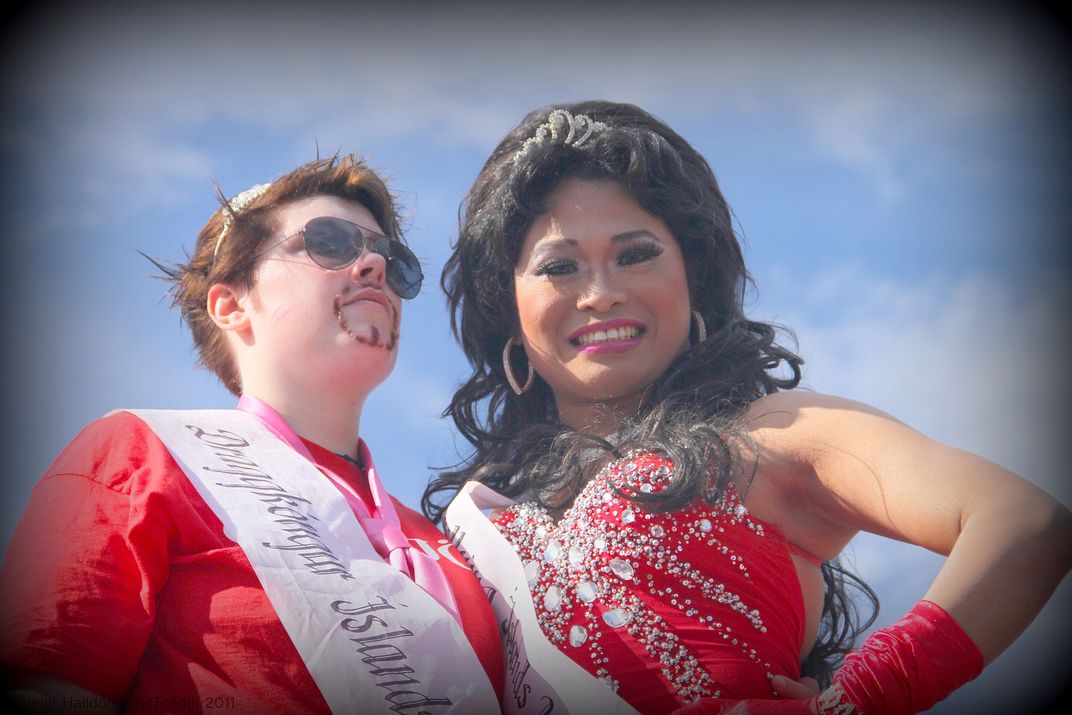These Newly Donated Artifacts Capture the Spirit of Washington, D.C. Drag
Mementos from the Academy of Washington drag organization add a valuable thread to the tapestry of American LGBTQ history
:focal(1173x407:1174x408)/https://tf-cmsv2-smithsonianmag-media.s3.amazonaws.com/filer/33/ab/33ab1632-67be-44b5-a6b1-e45d61cdb6cd/drag1.jpg)
Awards shows as a rule have a reputation for tedium and lack of pizzazz, but there is no way the programs put on by the Academy of Washington, which operated in Washington, D.C. for nearly 55 years, could ever be accused of blandness. Flashy and fun, the Academy’s presentations celebrated performance of a very specific variety: drag.
Incorporated in 1971 under the stewardship of female impersonator Alan Kress (stage name: Liz Taylor), the Academy was meant as a beacon of solidarity that members of Northeastern gay communities—then the targets of relentless harassment—could turn to for entertainment, escape and a sense of collective identity. The Academy oversaw a number of drag houses in the region around Washington, D.C., Baltimore and Richmond, where colorfully clad performers would vie for prizes in a lively and lighthearted atmosphere.
Last week, the Smithsonian’s Archives Center at the National Museum of American History welcomed into its collections an assortment of artifacts tied to the Academy of Washington, prepared and donated by former Academy treasurer Frank Taylor (stage name: Danielle Devereaux) and D.C.-based LGBTQ activist Mark Meinke. Ranging from glitzy photos and enticing event programs to more mundane receipts and ledgers, the items paint a rich picture of Academy activities across the organization’s storied lifespan.
/https://tf-cmsv2-smithsonianmag-media.s3.amazonaws.com/filer/fa/33/fa339c07-b1aa-4421-88c0-f70b97222ae6/drag3.jpg)
“Finding a run of an organization over this period of time is really extraordinary for a community like that,” says Smithsonian archives specialist Franklin Robinson, who points out that LBGTQ activities “were repressed, and certain behaviors were illegal.” The breadth of gay history represented by the Academy’s donations is truly remarkable, he says. “Having all that be documented… it’s pretty close to unique.”
While the solidarity that comes with organized drag is not to be taken lightly, assistant archives director Robert Horton emphasizes that Academy drag contests were not solemn gatherings but rather upbeat, rowdy revels. “It’s celebratory,” he says. “That’s why it has these performance aspects of music and dancing and dressing up.” It was in this exuberant climate that community bonds were forged. “It’s a party,” Horton says, “but it’s also a party of like-minded individuals who share something.”
The unity felt among Academy members was especially evident during the AIDS epidemic that rocked America in the 1980s and ’90s. “A lot of the Academy’s shows made money to help people who could not afford treatment,” says Robinson. “There was definitely a social consciousness aspect to the whole drag culture.”
One other facet of this social consciousness pertained to diversity. If it was to become a sanctuary for marginalized individuals in search of community, the Academy realized early on that it would have to be nondiscriminatory and welcoming in its own policies.

Many tend to think of drag as a male-only activity, but Robinson is quick to note that the Academy recognized drag kings as well as queens. Additionally, drag practitioners came together across racial lines—Robinson says African-Americans and Latinos were well-represented within the Academy’s ranks.
The wide-ranging appeal of the Academy and its message of gay positivity is evidenced by its long life. Only recently, following the passing of Academy icon Carl Rizzi (stage name: Mame Dennis) and amid a proliferation in casual drag shows across town, did the organization formally end its reign.
Rather than mourn its death, though, Robinson and Horton want to preserve and reflect on the Academy’s eventful life as a D.C. cultural staple. They are hopeful that the new additions to the museum's Archives Center will serve as inspiration for future advocates of gay rights. “There was drag material in our LGBTQ collection before, but nothing of this scope,” says Robinson. “This really helps us continue representing these underserved communities.”
/https://tf-cmsv2-smithsonianmag-media.s3.amazonaws.com/accounts/headshot/DSC_02399_copy.jpg)
/https://tf-cmsv2-smithsonianmag-media.s3.amazonaws.com/accounts/headshot/DSC_02399_copy.jpg)